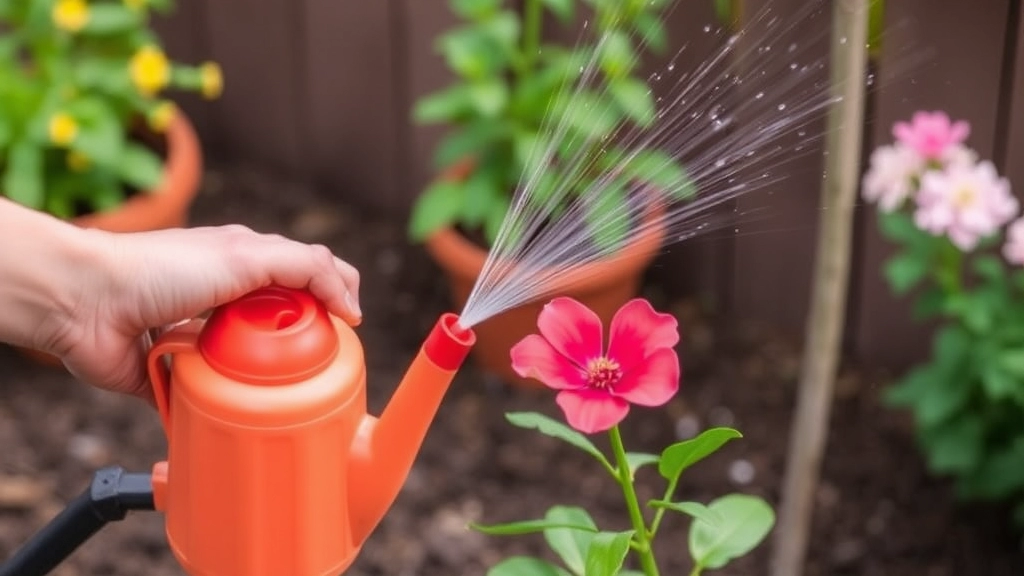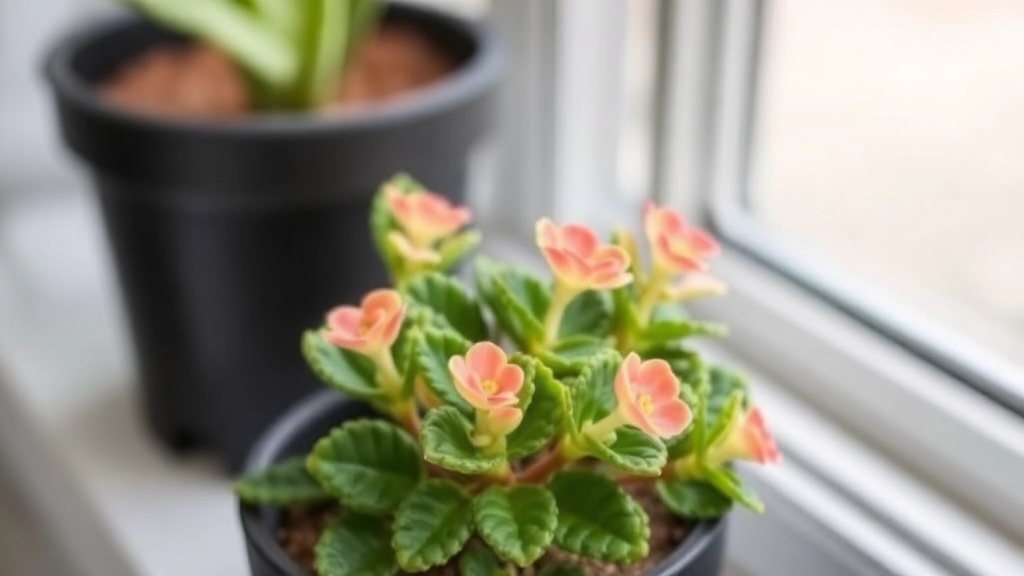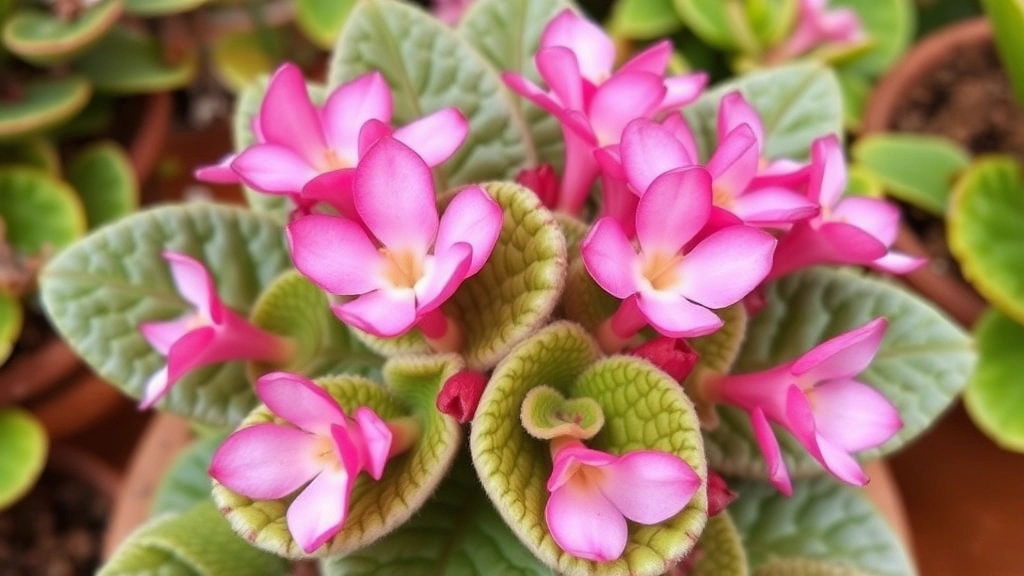Kalanchoe Brasiliensis Care
Looking to master Kalanchoe Brasiliensis care? You’ve come to the right place. This unique succulent thrives with the right balance of light, water, and temperature. Place your Kalanchoe in a spot with plenty of indirect sunlight to mimic its natural habitat. Overwatering is a common mistake, so water only when the soil is completely dry.
Soil and Temperature
Choosing the right soil is crucial for healthy growth. Opt for a well-draining mix and a pot with drainage holes to prevent root rot. Keep the temperature between 15-25°C and maintain moderate humidity.
Feeding and Pruning
Feeding your Kalanchoe with a balanced fertiliser every few months will ensure it gets the nutrients it needs. Regular pruning helps maintain its shape and promotes new growth.
Propagation and Care Tips
If you want to expand your collection, propagation is a breeze with this plant. Just be vigilant about pests and diseases, and adjust your care routine seasonally for optimal results.
Ideal Light and Placement for Kalanchoe Brasiliensis
Are you struggling to find the perfect light for your Kalanchoe Brasiliensis?
Understanding its light requirements is crucial for healthy growth.
Kalanchoe Brasiliensis thrives in bright, indirect sunlight.
Key Points to Consider:
- Direct Sunlight: While it can tolerate some direct sunlight, too much can scorch the leaves.
- Indoor Placement: A south or west-facing window is ideal, providing ample light without overwhelming the plant.
- Outdoor Conditions: If placed outdoors, ensure it is in a partially shaded area during the hottest part of the day.
Proper light not only encourages vibrant foliage but also enhances flower production.
If you notice your plant stretching towards the light, it may not be receiving enough.
Tips for Placement:
- Rotate your plant every few weeks to ensure even growth.
- Avoid placing it near drafty windows or heating vents, as sudden temperature changes can stress the plant.
For more tips on ensuring your Kalanchoe thrives, check out our top kalanchoe succulent varieties and care tips and learn how to plant Kalanchoe in a pot with our step-by-step guide.
Watering Routine: How to Avoid Overwatering and Underwatering

Are you worried about your Kalanchoe Brasiliensis wilting or rotting away? You’re not alone! Watering can be a tricky balance, especially for succulent lovers.
Finding the Right Balance
Kalanchoe Brasiliensis thrives when you nail the watering routine. Here’s how to keep it happy:
- Check the Soil: Always stick your finger about an inch into the soil. If it feels dry, it’s time to water. If it’s still damp, hold off.
- Water Thoroughly: When you do water, give it a good soak. Let the water drain out of the pot’s bottom. This ensures the roots are getting enough moisture.
- Frequency: Generally, watering every two to three weeks works well, but this can change with the seasons. In summer, you might need to water more often, while in winter, much less.
Signs of Overwatering and Underwatering
Keep an eye on your plant. Here are some signs to watch for:
- Overwatering: Yellowing leaves, mushy stems, or a foul smell from the soil.
- Underwatering: Wrinkled leaves or a droopy appearance.
By tuning into your plant’s signals, you can adjust your watering routine to keep it thriving.
Tips for Success
- Use Well-Draining Soil: This helps excess water escape.
- Choose the Right Pot: Make sure your pot has drainage holes.
- Seasonal Adjustments: Remember, your plant’s needs change with the weather.
When it comes to nurturing your Kalanchoe Brasiliensis, the right soil and pot selection can be the difference between a thriving plant and one that struggles. You might be wondering, “What type of soil should I use?” or “How do I choose the right pot?” Let’s dive into these essential aspects.
### Soil Selection
Kalanchoe Brasiliensis thrives in well-draining soil. Here are a few key points to consider:
– **Cactus Mix**: A pre-mixed cactus or succulent soil is ideal. This type of soil allows excess moisture to escape, which is crucial for preventing root rot.
– **DIY Soil Mix**: If you prefer to create your own mix, combine:
– 50% potting soil
– 25% perlite
– 25% coarse sand
– **pH Level**: Aim for a slightly acidic to neutral pH (around 6.0 to 7.0) to encourage healthy growth.
### Pot Selection
Choosing the right pot is equally important. Here are some tips to keep in mind:
– **Drainage Holes**: Always opt for pots with drainage holes. This allows excess water to escape, preventing soggy roots.
– **Material Matters**: Terracotta pots are a popular choice because they absorb moisture and help regulate soil moisture levels. However, plastic pots can also work if they have proper drainage.
– **Size**: Select a pot that is slightly larger than the root ball. This gives your Kalanchoe room to grow without being too spacious, which can lead to overwatering.
For more detailed care tips, you might find our [Complete Care Guide for Kalanchoe Synsepala Baker](https://planthq.org/complete-care-guide-for-kalanchoe-synsepala-baker/) useful. Additionally, if you’re interested in other varieties, check out our guide on [Top Kalanchoe Varieties with Pink Edges](https://planthq.org/top-kalanchoe-varieties-with-pink-edges/).
Temperature and Humidity Requirements for Thriving Kalanchoe Brasiliensis

As we delve deeper into the care of Kalanchoe Brasiliensis, it’s essential to consider the environmental factors that significantly influence its growth.
Ideal Temperature Range
Kalanchoe Brasiliensis thrives best in a warm environment. Here are some key temperature guidelines:
- Daytime Temperature: Aim for between 20°C to 25°C (68°F to 77°F).
- Nighttime Temperature: A drop to around 15°C to 18°C (59°F to 64°F) is ideal.
- Avoid Extreme Cold: Temperatures below 10°C (50°F) can stress the plant.
Humidity Levels
Kalanchoe Brasiliensis is a succulent and prefers drier air. Here’s how to manage humidity effectively:
- Optimal Humidity: Keep humidity levels around 30% to 50%.
- Avoid High Humidity: Excess moisture can lead to root rot and fungal diseases.
Tips for Maintaining Temperature and Humidity
- Indoor Placement: Keep your Kalanchoe Brasiliensis near a sunny window but away from drafts or air conditioning vents.
- Use a Thermometer: Monitor the temperature regularly to ensure it remains within the ideal range.
- Humidity Control: If humidity is high, consider using a fan or dehumidifier to create a drier environment.
Real-Life Example
I once had a friend who struggled with her Kalanchoe Brasiliensis. She kept it in a humid bathroom, thinking it would thrive. Instead, it developed root rot. Once she moved it to a more controlled environment, the plant flourished!
Fertilization Guidelines: How and When to Feed Your Kalanchoe
As we delve deeper into the care of your Kalanchoe Brasiliensis, understanding its fertilization needs is essential for promoting vibrant growth and stunning blooms.
When to Fertilize Your Kalanchoe
Timing is everything when it comes to fertilizing your Kalanchoe. Here’s a simple breakdown:
- Spring and Summer: This is the active growing season. Feed your plant every 4-6 weeks.
- Autumn: Reduce feeding as growth slows down.
- Winter: No need to fertilize during the dormant period.
What Type of Fertilizer to Use
Choosing the right fertilizer can make a significant difference. Consider these options:
- Balanced Fertilizer: A 10-10-10 or similar NPK ratio works well.
- Liquid Fertilizer: Easy to apply and absorbs quickly.
- Slow-Release Granules: Ideal for those who prefer less frequent feeding.
How to Apply Fertilizer
Application methods can vary, but here are some practical tips:
- Dilution: Always dilute liquid fertilizers to half strength to avoid burning the roots.
- Watering First: Water your plant a day before fertilizing to ensure it’s not stressed.
- Even Distribution: Apply evenly around the base, avoiding direct contact with the leaves.
Signs Your Kalanchoe Needs Fertilization
Keep an eye out for these indicators:
VI. Pruning Techniques for Shape and Health Maintenance
So, you’ve got your Kalanchoe Brasiliensis thriving, but you might be wondering: how do I keep it looking its best? Pruning is a game-changer for maintaining both shape and health.
Why Prune?
Pruning isn’t just about aesthetics; it promotes growth and prevents overcrowding. It helps your plant focus its energy on new leaves and blooms.
When to Prune:
– Spring: This is the ideal time to give your plant a trim. It’s waking up from dormancy and ready for some TLC.
– After Flowering: If your Kalanchoe has bloomed, it’s a good idea to prune back any spent flowers and leggy growth.
How to Prune:
– Use Clean Tools: Always start with clean, sharp scissors or pruning shears to avoid introducing any pests or diseases.
– Cut Above a Node: Snip just above a leaf node (the little bump where leaves emerge). This encourages new growth.
– Remove Dead or Damaged Leaves: Trim away any leaves that look unhealthy. This keeps your plant looking fresh and vibrant.
Tips for Pruning:
– Don’t Overdo It: A light trim is often all that’s needed. You don’t want to stress your plant too much.
– Keep an Eye on Growth: If you notice your Kalanchoe getting too leggy, it’s time for a trim.
Propagation Methods: Expanding Your Succulent Collection
Have you ever wondered how to expand your Kalanchoe Brasiliensis collection without breaking the bank? Propagation is a fantastic way to grow your plant family, and it’s easier than you might think.
Pest and Disease Control: Preventing Common Issues

So, you’ve got your Kalanchoe Brasiliensis thriving, but what happens when pesky pests or sneaky diseases show up uninvited?
Let’s face it, nobody wants to see their beautiful succulent looking sad and droopy.
Common Pests to Watch Out For
- Mealybugs: These little white cottony critters love to hide in the nooks and crannies. They suck the sap from your plant, making it weak.
- Aphids: Tiny and green, they can be hard to spot. They also feed on sap and can spread diseases.
- Spider Mites: If you notice fine webs on your plant, these guys might be the culprits. They thrive in dry conditions.
Signs of Trouble
- Yellowing leaves?
- Stunted growth?
- Tiny spots or webs?
These could be signs of pest problems or diseases.
Prevention Tips
- Keep It Clean: Regularly wipe down your leaves with a damp cloth. This removes dust and makes it harder for pests to settle in.
- Quarantine New Plants: If you bring home a new plant, keep it away from your Kalanchoe for a couple of weeks. This way, you can catch any issues before they spread.
- Natural Predators: Consider introducing ladybugs or lacewings. They’ll munch on those pesky aphids and mealybugs.
Treatment Options
- Neem Oil: This is a natural pesticide that works wonders. Mix it with water and spray it on affected areas.
- Insecticidal Soap: Another effective option. Just make sure to follow the instructions on the label.
- Manual Removal: For mealybugs, you can dab them with a cotton swab dipped in alcohol.
Keeping an eye on your Kalanchoe Brasiliensis will help it stay healthy and happy.
Seasonal Care Adjustments for Kalanchoe Brasiliensis
As we transition through the seasons, caring for Kalanchoe Brasiliensis requires some adjustments to ensure optimal growth and health.
Spring: Awakening Growth
In spring, your Kalanchoe will begin to wake up from its winter dormancy.
- Increase Light: As days grow longer, ensure your plant receives more sunlight.
- Watering: Start watering more frequently, but always check the soil first to avoid overwatering.
- Fertilisation: Introduce a balanced fertiliser every four to six weeks to promote new growth.
Summer: Thriving Conditions
During the summer months, your Kalanchoe will thrive with the right care.
- Sun Protection: While it loves sunlight, direct afternoon sun can scorch its leaves. Consider providing some shade during peak hours.
- Humidity: Ensure the environment remains dry to prevent rot.
- Watering: Increase watering frequency, but always let the soil dry out between sessions.
Autumn: Preparing for Dormancy
As autumn arrives, your Kalanchoe will start preparing for dormancy.
- Reduce Watering: Cut back on watering as temperatures drop and growth slows.
- Check for Pests: This is a good time to inspect for any pests that may have appeared during the summer.
- Fertilisation: Stop fertilising as the plant enters its rest phase.
Winter: Dormant Phase
In winter, your Kalanchoe will need minimal care.
- Light: Ensure it still receives adequate light, even if it’s indirect.
- Watering: Water sparingly; the plant is dormant and does not require much moisture.
- Temperature: Keep it in a warm area, avoiding cold drafts that could harm the plant.
For more detailed care instructions, you can refer to our comprehensive guide to caring for Kalanchoe Brasiliensis. Additionally, if you’re interested in exploring other Kalanchoe species, our guide to different Kalanchoe species might be helpful.
FAQs on Kalanchoe Brasiliensis Care
How often should I water my Kalanchoe Brasiliensis?
Water your Kalanchoe Brasiliensis every two to three weeks. However, this can vary with the seasons. In summer, you may need to water more frequently, while in winter, you can reduce the watering.
What are the signs of overwatering and underwatering?
Overwatering can cause yellowing leaves, mushy stems, or a foul smell from the soil. Underwatering may result in wrinkled leaves or a droopy appearance.
What type of soil is best for Kalanchoe Brasiliensis?
Use well-draining soil to help excess water escape. This prevents root rot and other water-related issues.
What is the ideal temperature range for Kalanchoe Brasiliensis?
Kalanchoe Brasiliensis thrives in daytime temperatures between 20°C to 25°C (68°F to 77°F) and nighttime temperatures around 15°C to 18°C (59°F to 64°F). Avoid temperatures below 10°C (50°F).
How do I manage humidity levels for my Kalanchoe Brasiliensis?
Keep humidity levels around 30% to 50%. Avoid high humidity as it can lead to root rot and fungal diseases.
When is the best time to prune my Kalanchoe Brasiliensis?
The ideal time to prune is in spring or after flowering. This helps promote new growth and maintain the plant’s shape.
What are common pests that affect Kalanchoe Brasiliensis?
Common pests include mealybugs, aphids, and spider mites. These pests can cause yellowing leaves, stunted growth, and tiny spots or webs on the plant.
How can I prevent pest and disease issues?
Regularly wipe down the leaves with a damp cloth, quarantine new plants, and consider introducing natural predators like ladybugs. These steps can help keep pests and diseases at bay.
What are some effective treatments for pest infestations?
Neem oil and insecticidal soap are effective treatments. For mealybugs, you can also manually remove them using a cotton swab dipped in alcohol.
Can I keep my Kalanchoe Brasiliensis indoors?
Yes, you can keep it indoors near a sunny window. Just ensure it’s away from drafts or air conditioning vents to maintain the ideal temperature and humidity levels.
References
-
How to Grow and Care for Kalanchoe Plants
-
Kalanchoe Plant Care â How To Grow A Kalanchoe
-
Kalanchoe: How to Care for Kalanchoe Plants
